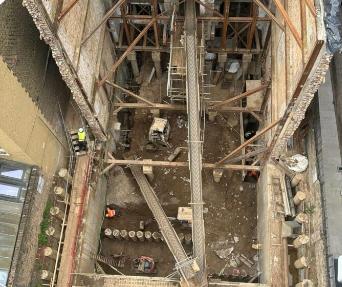Concrete piling is essential in today’s construction scene for building a strong and reliable foundation, particularly in regions with poor or unstable soil. To support structures like buildings, bridges, or retaining walls, this approach calls for pushing or drilling deep columns of reinforced concrete into the earth. Concrete piles guarantee long-term stability and structural integrity by transferring the load of the building to deeper, stronger layers of earth or rock. Concrete piling offers a consistent way to construct safely on difficult terrains as urban expansion keeps rising, hence reducing the danger of structural shifting or damage.
Basement Construction: More Than Just Storage Space
From a basic storage option, the basement building has developed into a major component of contemporary house architecture. Homeowners now see basements as useful living spaces that might be converted into home offices, guest rooms, or entertainment spaces. Basement construction not only increases square footage but also greatly raises the value of the house. Efficient basement building guarantees a practical and comfortable room by including waterproofing, insulation, and ventilation systems. Basements can be customised to fit lifestyle needs with good design and the employment of qualified experts, supporting the general energy efficiency and usability of a house.
Improving Home Foundations using Modern Piling Methods
The development of piling systems is among the significant developments in structural engineering. From boring piles to driven piles, technology has increased the accuracy and dependability of pile installation. Modern piling equipment provides the least disturbance to the neighbouring buildings and surrounding environment. Maintaining structural balance depends on the correct piling technique, whether one is building residential homes or commercial areas. When choosing piling techniques, engineers take into account soil type, load-bearing needs, and groundwater levels. By means of this thorough evaluation, the basis is both reasonably priced and long-lasting, hence establishing the basis for safe and robust building.
Waterproofing Strategies for Lasting Basements
Any effective basement project depends on waterproofing. Basements are susceptible to moisture, mould, and long-term structural damage without sufficient waterproofing. To guarantee basements stay dry all year round, modern waterproofing systems combine external membranes, internal drainage, and sump pumps. These solutions will help prevent the entry of water caused by problems such as leakage in plumbing, groundwater pressure, and rain. By choosing top-quality waterproofing systems and passing installation to professionals, you can avoid future costs of repairs to your basement and home. Also, a dry basement ensures good air quality, consumes less energy and increases daily comfort.
Energy Efficiency by Subterranean Design
Their location below ground naturally improves insulation. Therefore, basements are a major factor in housing energy efficiency. Basements cut energy costs by reducing the pressure on heating and cooling systems by means of more consistent internal temperatures. When used along with passive ventilation and state-of-the-art insulation, basements have environmental benefits. The green building practices that are used during the construction of basements are useful to homeowners for the purposes of protecting the environment and achieving economic benefits over the years. Basement spaces appear as the key players for sustainable development, particularly when it comes to the cutting-edge construction that is focused on energy saving.
Smart Basement Project Planning
There are different critical considerations in the planning of a basement project, among them, design layout, legal clearances, and structural evaluations. In most local building ordinances, minimum standards for ceiling height, egress points, and good waterproofing are set. By leveraging the professional experience of informed architects and engineers, your basement is going to comply with legal and safety standards. Extensive planning includes selecting sustainable materials right from the beginning and incorporating any hidden costs. Through regular evaluation of your project and encouraging open communication with your contractor, you can prevent setbacks and unexpected expenses. Creating a basement that will be a long-term addition to your house and a valuable one will need a well-planned strategy.
Conclusion
Two basic components of robust and future-proof building projects are concrete piling and basement construction. While basement development increases habitable area, energy efficiency, and long-term property value, concrete piling guarantees that the building is supported on solid, stable ground. Together, they provide a strong mix of usability and strength to support above-ground as well as below-ground design requirements. Those who use these techniques are not only strengthening their homes but also maximising functional space and contemporary living standards. Visit bhbasements.co.uk for expert advice and dependable basement services to investigate industry-leading solutions customised to your requirements.

